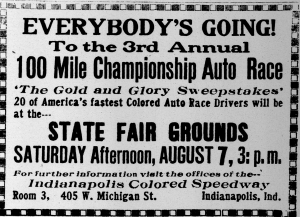Blog Archives
Racing Along the Color Line

A July 31, 1926 advertisement in the Indianapolis Recorder for the third running of the Gold and Glory Sweepstakes.
This month the massive crowds at the Indianapolis Motor Speedway appear to confirm its confident claim to being the “motor racing capital of the world.” Racing began on the oval in 1909 and the 500-mile race first ran two years later, with the 99th running of the 500-mile race approaching on Memorial Day weekend. The speedway is a National Historic Landmark, and its fascinating social history reaches well beyond the obsessive statistics and biographical minutia that motorheads have compulsively detailed for a century. The IMS dominates American racing mythology and is as much a pilgrimage destination as a race track. Like so many shrines it invokes a host of American traditions that are perhaps more firmly rooted in our imagination and hagiography than especially concrete history.
The imagination of the speedway’s history has recently begun to contemplate historical racial inequalities in sports. This year the 500 Festival parade before the race will be marshalled by the 1955 state high school basketball champions from Indianapolis’ segregated Crispus Attucks High School. The Attucks champions’ place in the pre-race parade celebrates Indiana’s two most adored sports, basketball and racing, but of course the implications of sport and the color line extend beyond the hardwood and the speedway. No 20th-century Indiana institution escaped anti-Black racism, and the speedway and the Indianapolis 500 was long a segregated space and has included very few people of color on the track or in the pits. The prominence of the Attucks players makes a modest but potentially important concession of racism in sports, though the concrete social effects of such discussions remain to be evaluated. Read the rest of this entry

